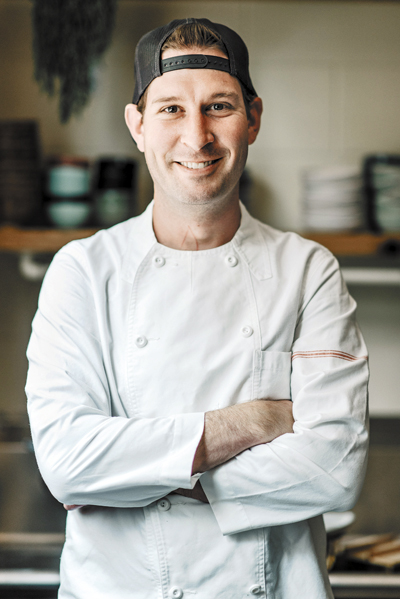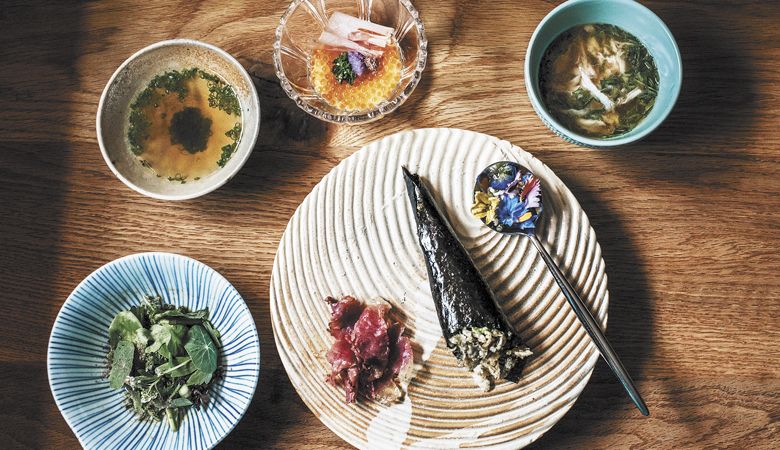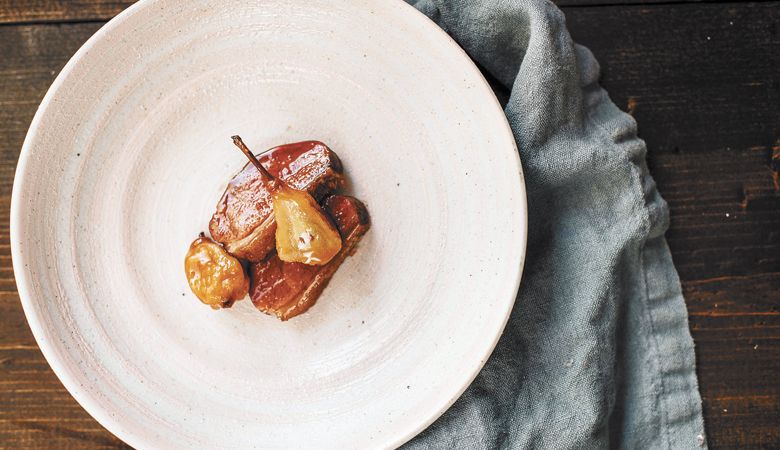Less Is MÄS
Ashland restaurant elevates local, seasonal cuisine
By Sophia McDonald
In Spanish, the word “más” means more. In Josh Dorcak’s world, MÄS may as well mean less is more. The plates presented at his renowned Ashland restaurant are small, but each is packed with flavor and meaning. Under Dorcak’s experienced hand, simple ingredients — many sourced from local farms, forests or the restaurant’s garden — blend to create a celebration of regions, seasons and gastronomic creativity. When paired with natural, organic wines, they translate to a thoughtful story worth telling again and again.
MÄS, which Dorcak runs with business partner Luke VanCampen, is the culmination of his 17-year love affair with food and fine dining. He grew up in a Silicon Valley family that cooked and ate together frequently. “The dinner table was definitely a focal point of everyone getting along and having a good time,” he said. “It was a safe place.”
After high school, he followed a friend to the California Culinary Academy and immediately knew he’d found his calling. His certainty deepened with more exposure to high-end restaurants and hotels. “I just fell in love with how nice things could be,” he said. “Going to a nice restaurant is a magic show. How do you get things to work? How do you get food to look like that?”

After graduation, he moved to Southern Oregon and accepted a job at Amuse, a Northwest-French restaurant and mainstay in the community for nearly 20 years. He took temporary stints at restaurants in the Netherlands and Arizona, but he always knew he’d return to Ashland. After spending several more years at Amuse, Dorcak ran and opened kitchens at other eateries.
The challenge with a cooking career in the Rogue Valley, though, is that it’s a relatively small place with few opportunities to advance. “Coming back to this area, I felt like there was something more to be done with the food and dining culture. That started the seed of doing a restaurant like MÄS,” he said.
That desire deepened when he met VanCampen, originally hired to wash dishes in his restaurant. They immediately hit it off and started talking about opening a restaurant. The biggest roadblock was making it financially sustainable. Every time Dorcak started to put together a business plan, he looked at the labor portion of the budget and stopped. “You can have the best idea in the world, but how do you pay for all these people?” he queried.
He and VanCampen found a solution on a trip to Japan. In Tokyo, they discovered a restaurant managed with the “four hands” concept. In this model, all of the work in a restaurant — cooking, serving, cleaning — is accomplished by two people. The concept solved the labor question and was a perfect fit with both men’s lifestyle — Dorcak describes his business partner as having “an insane work ethic.”
As soon as they returned from Japan, Dorcak quit his job and started pondering his next move.
He started visiting local farmers and ranchers to see what they were producing. “That’s when I was like, ‘Oh my gosh, we live in an agricultural gold mine,’” he said. “I was living in every chef’s dream. Where else can you go 15 minutes in every direction and be out of a city and find clean, edible food and be on some really unique farm?”
Dorcak wanted to highlight ingredients available within the Cascadia Bioregion — stretching from Alaska to Northern California — with a special emphasis on Southern Oregon. This focus dovetailed perfectly with the food culture of Japan, which he greatly admires. “It really elevates the seasons and all the little ones in between,” he said. “It’s hyper-focused on what’s happening now, and preserving it and treating it with extreme respect.”
Although Dorcak’s focus on quality occasionally causes him to stray to Japan for ingredients, most of what diners find at MÄS comes from along the Pacific Coast. He brings in Wagyu beef raised near Gold Beach, fish and shellfish from Alaska, duck from Sonoma County, mushrooms foraged from local forests and vegetables grown in the restaurant’s garden. Those ingredients go into dishes such as caviar and popcorn; prawns paired with green tomatoes; octopus tossed with melon and Buddha’s hand miso; Wagyu with matsutake mushroom and garlic; and duck with huckleberries and squash.
On the wine list, patrons will find only natural and organic options. “Pairings are a day-of thing,” Dorcak said. “Whatever the menu is, I go through the wines we have and pick them more based on emotion rather than (matching the flavor profile). I don’t look at it with a lens of pretention at all.” Local choices may include amphora and skin-contact wines from Troon Vineyards or products from Chad Hines of Methode Sauvage and iruai. Dorcak is also a fan of Austrian varieties such as Grüner Veltliner, Sylvaner and Blaufränkisch. “These are wines that make you think,” he said.
While it’s been challenging for MÄS to weather the pandemic, there have been some bright spots. “It’s allowed us to take a step back and rethink the food a little bit,” Dorcak said. “We’re serving fewer people, but we’re more profitable. We have more time, and the food is better.” Before, people would often rush through their dinner so they could make an 8 p.m. play at the Oregon Shakespeare Festival. Now, with nowhere else to go, people can give más attention to the dining experience — which was Dorcak and VanCampen’s goal all along.











